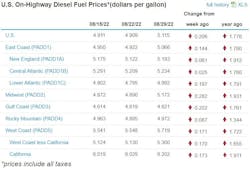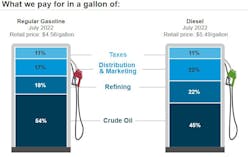Diesel prices have done nothing halfway this year. The U.S. average for trucking’s main fuel spiked 20.6 cents to $5.115 per gallon for the week of Aug. 29, the first increase in more than two months and first time the average has risen above $5 since the beginning of August, according to the U.S. Energy Information Administration (EIA).
Diesel set a per-gallon record this summer for the week of June 20, when the U.S. average surged to $5.81. The largest-ever week-over-week increase remains the early March 74.5-cent surge shortly after the Russian invasion of Ukraine, according to EIA.
The U.S. average for trucking's main fuel is now $1.776 per gallon more than it was a year ago, according to the federal agency.
See also: Diesel price decline slows
For the week of Aug. 29, every region of the country saw a large diesel price increase. The Midwest—where there were mounting supply concerns this week—had the largest one, 28.2 cents to $5.172 per gallon, followed by the Gulf Coast, where trucking’s main fuel surged 20.2 cents to $4.821. Diesel rose 17.1 cents on the West Coast—traditionally the most expensive place in the U.S. to buy the fuel—to $5.719 while it increased 14.4 cents to $5.066 per gallon on the East Coast. The Rocky Mountain region saw a relatively modest increase, 8.7 cents to $4.972.
Technical problems prevented EIA on Aug. 29 from releasing its weekly gasoline price data, but by Aug. 30 the agency had cleared up those problems and reported that the nationwide average for gas dropped another 5.3 cents to $3.827 per gallon for the week. But even gasoline is still 68.8 cents more expensive per gallon than it was a year ago across the U.S., according to EIA.
AAA, too, is tracking the curious trend of diesel creeping up above $5 per gallon while gasoline continues to fall well below $4. AAA had its weekly average for diesel on Aug. 29 at more than a nickel above the $5 level at $5.057 per gallon—up from $4.977 last week—while the motor club had gas at $3.850, down a nickel from Aug. 22. AAA tracks nationwide and state prices for all grades of gas and diesel daily as well as weekly, while EIA only does so weekly and regionally.
Supply the current driver of price volatility
Supply looks to be the cause of the reversal of diesel’s downward trend since mid-June. According to an Associated Press report, diesel and heating oil supplies in the Northeast are more than 50% below the recent average, raising concerns that an extreme weather event could cause supply disruptions, federal officials said.
Fuel supplies are lower than normal across the country for a variety of reasons, including the war in Ukraine. But it's the worst in the Northeast.
See also: Motive: Tracking vehicle, driver data saves fleets up to 13% on fuel
Diesel fuel and heating oil are 63% below the five-year average in New England and 58% below the same average from Maryland to New York, a survey by the U.S. Energy Department said, according to The Associated Press. Gasoline inventories are not as bad but are still at their lowest levels in nearly a decade along the entire East Coast, according to the Energy Department.
Meanwhile, federal regulators acted to bolster the supply of gasoline, diesel, and jet fuel to four Midwestern states last weekend after the disruptive shutdown of the BP refinery in Whiting, Indiana, due to an Aug. 24 fire at the facility, according to a report from Bulk Transporter, a sister publication to FleetOwner.
The Federal Motor Carrier Safety Administration (FMCSA) declared a regional emergency and issued a temporary hours-of-service exemption that creates flexibility for motor carriers and drivers transporting fuel and other refined petroleum products to Illinois, Indiana, Michigan, and Wisconsin.
The emergency declaration will remain in effect until midnight on Sept. 10, or the end of the emergency, FMCSA said in a release.
“U.S. DOT’s top priority is safety, and while current circumstances dictate providing industry flexibility, FMCSA has notified and will work closely with its state and industry partners to monitor driver work hours and conditions for the duration of the exemption,” the agency said in the release.
See also: Cummins finds more than one way to decarbonize fleets
In addition, the U.S. Environmental Protection Agency's (EPA) administrator, Michael Regan, issued an emergency fuel waiver to help alleviate fuel shortages in the affected states. The waiver, which will continue through Sept. 15, applies to State Implementation Plan requirements for fuel volatility on gasoline sold in Illinois, Indiana, Michigan, and Wisconsin, according to EPA.
As a result of the BP refinery shutdown, Regan “determined that extreme and unusual fuel supply circumstances exist and has granted a temporary waiver to help ensure that an adequate supply of gasoline is available in the affected areas until normal supply to the region can be restored,” EPA explained in a statement.
FMCSA’s declaration provides relief from certain requirements of the Federal Motor Carrier Safety Regulations (FMCSRs), specifically the maximum driving time for property-carrying vehicles. Direct assistance does not include routine commercial deliveries, including mixed loads with a nominal quantity of qualifying emergency relief added to obtain the benefits of this emergency declaration, according to the U.S. trucking regulator.
Oil prices, which usually correlate with diesel prices, have started to tick back up again, hovering from $95 per barrel to above $100 again. So, besides supply, oil prices might disrupt any further de-escalation of prices for trucking’s main fuel from the record high prices from March through June.







